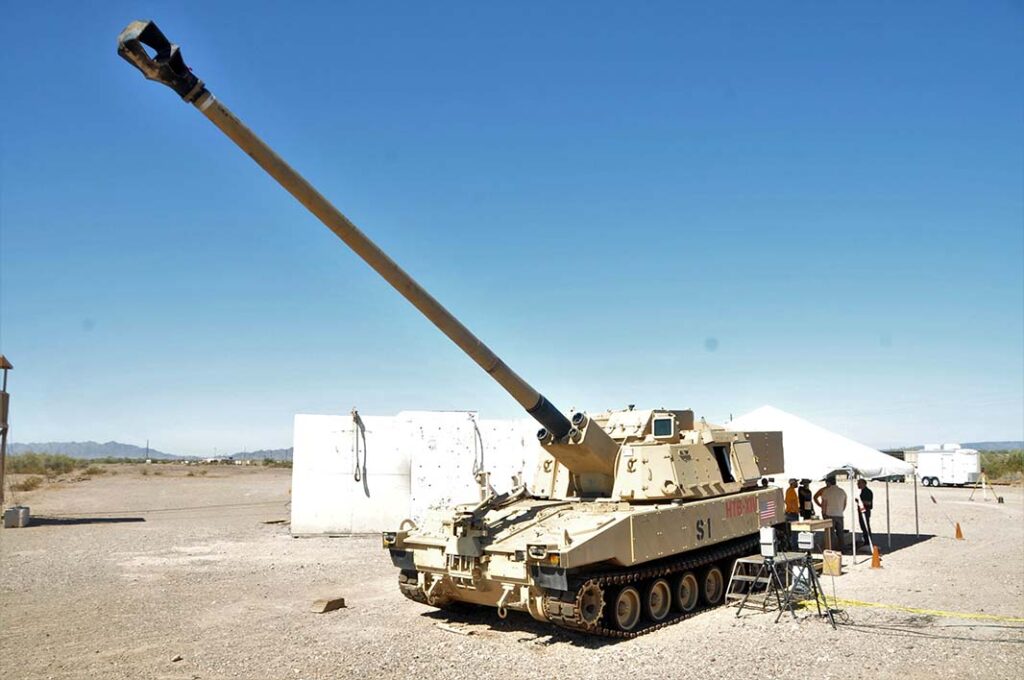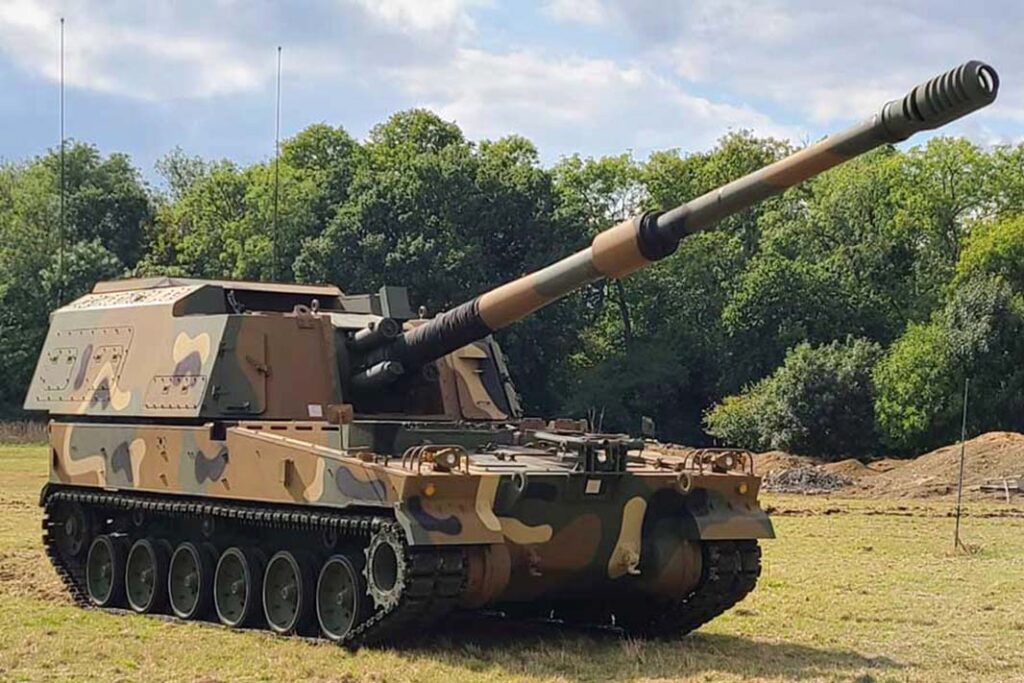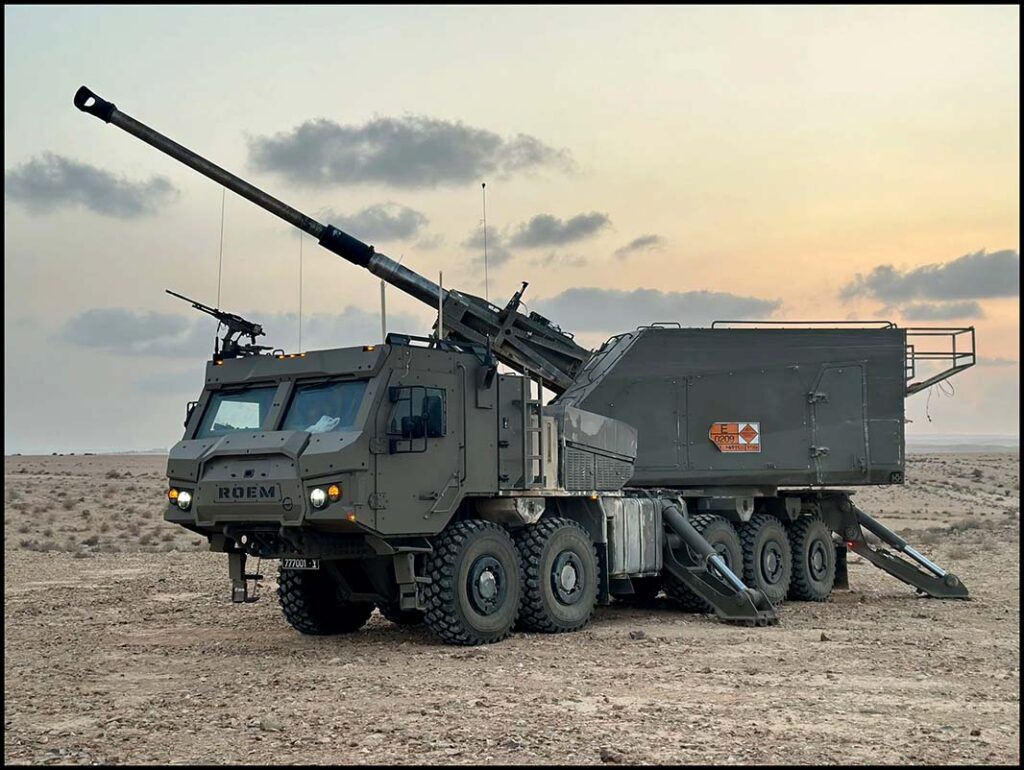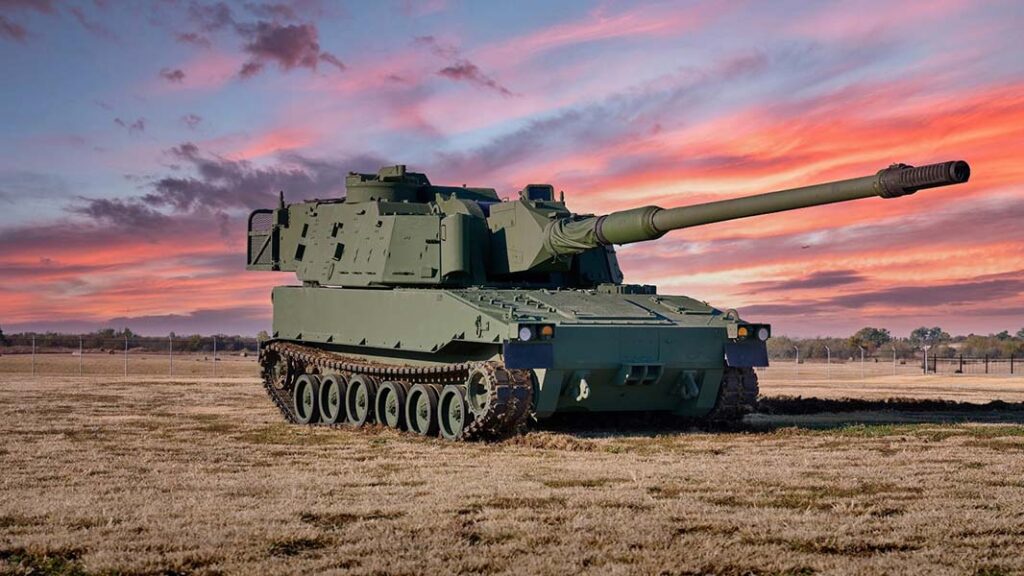More than six decades after the M109 entered service and following a series of cancelled replacement programmes costing billions, the US Army is once again seeking a new self-propelled artillery system, but the path forward remains uncertain.
At the Association of the US Army (AUSA) exposition in Washington, DC, in October 2025 numerous artillery system manufacturers will present – just as they were at AUSA 2024 – their prospective solutions for the US Army’s Self-Propelled Howitzer Modernization (SPH-M) programme.
However, despite the Army having previously indicated that an SPH-M request for proposals (RFP) was set for February 2025, it appears that no real progress with the programme will happen before 2026.
The long road to SPH-M
The US Army’s current tracked SPH, the M109, first entered service in 1963 and has been progressively upgraded since then, with the latest variant, the M109A7, having entered in April 2015. Efforts to find a replacement system, however, go back to 1994, when the US Army began to develop the Crusader 155 mm SPH. This project was then cancelled in May 2002 when then US defence secretary Donald Rumsfeld determined that future enemy threats did not require the Crusader and other emergent technologies should be prioritised.
From 2003 the Army then began to develop the Non-Line-of-Sight Cannon (NLOS-C) as part of its Future Combat System (FCS) family of FVs, but the whole FCS programme was cancelled in 2009 due to concerns over affordability and technological readiness and amid a preoccupation with the counter-insurgency campaigns in Iraq and Afghanistan that the Army was fighting at the time. Overall the FCS programme had little to show for a total of USD 32 billion spent (EUR 24 billion at the time).
More recently, in 2018, the US Army embarked upon the Extended Range Cannon Artillery (ERCA) programme, the prime intention of which was to extend the US Army’s reach with SPHs from 30 km to 70 km. With this in mind the ERCA prototypes comprised a US Army-developed 155 mm L58 gun turret mounted on an M109A6 Paladin Integrated Management (PIM)/M109A7 platform.

In parallel to the ERCA effort, back in July 2020 the US Army issued an RFP for a 155 mm Wheeled Gun System (WGS) as a faster, lighter and more mobile alternative to the M109A6 Paladin. The intention here was to provide a mobile 155 mm platform that could provide organic artillery support to the Army’s wheeled Stryker Brigade Combat Teams (SBCTs).
This led to a shoot-off in 2021 involving the BAE Systems Bofors Archer system, the ATMOS 2000 from Elbit Systems USA, the CAESAR system from France’s Nexter, the NORA B-52 system from Serbia’s Yugoimport-SDPR, and a sole purely US candidate in the form of the Brutus system, which was jointly developed by AM General and Mandus Group and mates a low-recoil 155 mm M776 gun with a Family of Medium Tactical Vehicles (FMTV) 6×6 truck.
Under the ERCA programme the Army conducted a number of successful tests with prototypes; in December 2020, for example, at Yuma Proving Ground in Arizona, one of them used an M982A1 Excalibur extended-range precision munition to achieve a direct hit at 70 km. However, engineering issues, such as excessive wear on the L58 gun barrel after firing a relatively small number of rounds, led to the ERCA prototyping effort’s discontinuation in April 2024.

Meanwhile, in a US Army Fiscal Year (FY) 2025 budget estimates document published in March 2024 a new line appeared for a Next-Generation Howitzer (NGH). This system, the document stated, “will provide highly mobile, survivable, versatile, transportable, longer range fire support under a broad set of challenging operational conditions against current and emerging small- to large-scale threats through 2040 and beyond”. Additionally, the document stated that the NGH “reduces emplacement and displacement times, provides increased crew survivability and better cross-country mobility, adds overall effectiveness, and affords improved fire support capability for field artillery formations well beyond what towed howitzer systems can provide”. The NGH procurement has now become known as the Self-Propelled Howitzer Modernization (SPH-M) programme.
In October 2024 the US Army awarded Other Transaction Agreement (OTA) performance demonstration contracts to five potential SPH-M suppliers: American Rheinmetall Vehicles, BAE Systems Bofors, Hanwha Defense USA, General Dynamics Land Systems and Elbit Systems USA. Those demonstrations, which began in November 2024, were intended to inform multiple SPH-M lines of effort as identified in the US Army’s Cannon Transformation Strategy.
At this time Major General Glenn Dean, the US Army’s Program Executive Officer for Ground Combat Systems, gave some further insight into the termination of the ERCA programme. He explained that the Army “made the decision to close out the ERCA Rapid Prototyping effort as we determined further maturation and redesign of the 58-calibre cannon was required before we could transition into an acquisition pathway”. He additionally noted that the Army was “exploring a range of options within the US and internationally in order to leverage mature and available industry solutions to fulfil critical capability gaps within the Army”, adding that the demonstrations “will support the Army’s pivot from development to procurement of a mature, available and non-developmental system”.
With regard to the SPH-M programme, as February 2025 came and went with no RFP forthcoming, it subsequently emerged that the US Army is now planning for more firing demonstrations at Yuma Proving Ground at the beginning of 2026. These are supposed to constitute a nine-month evaluation process, after which the Army intends to refine requirements and develop a more detailed procurement strategy.
Lessons from Ukraine
While the US Army had already embarked on seeking a 155 mm Wheeled Gun System back in July 2020, the conduct of the war in Ukraine since Russian forces invaded in February 2022 has brought sobering lessons with regard to the vulnerability of towed artillery systems. Unable to ‘shoot and scoot’ like an SPH, towed systems in Ukraine have been susceptible to counter-battery fire from both hostile artillery systems and loitering munitions, given the extended times they require to redeploy.
At the AUSA Global Force 2024 symposium, held in Huntsville, Alabama, from 26-28 March that year, the head of US Army Futures Command, General James Rainey, told the audience, “I personally believe that we have witnessed the end of the effectiveness of towed artillery; the future is not bright for towed artillery.”
That said, BAE Systems announced in April 2025 that it had been awarded a USD 162 million US Army contact for major titanium structures for the M777 lightweight towed howitzer, which is in current US service.
Potential candidates moving forward
With the US Army yet to fully refine requirements for a new weapon under the SPH-M programme, it is hard to say whether such a system will ultimately be tracked or wheeled, although the need for a wheeled system to accompany the Stryker Brigade Combat Teams presumably remains.
With that being the case various contending systems, both tracked and wheeled, are currently being pitched to the US Army. Most obviously there are the five potential SPH-M suppliers awarded OTA performance demonstration contracts in October 2024: American Rheinmetall Vehicles, BAE Systems Bofors, Hanwha Defense USA, General Dynamics Land Systems (GDDS) and Elbit Systems USA.
In late 2024 Rheinmetall demonstrated to the US Army its 155 mm Remote Controlled Howitzer (RCH 155) system, which takes the 155 mm L52 gun from the KNDS Deutschland PzH 2000 tracked SPH and integrates this with the company’s Artillery Gun Module (AGM) mounted onto a Boxer 8×8 multi-role armoured vehicle. The system offers a rate of fire of eight rounds per minute, with range dependent on the ammunition used (up to 40 km with base-bleed ammunition, up to 54 km with V-LAP ammunition or further with extended-range ammunition such as Excalibur rounds.

In recent years, meanwhile, Rheinmetall has worked with Elbit Systems to develop an automated 155 mm wheeled SPH. This system, which is ostensibly focused on European requirements, features Rheinmetall’s 155 mm L52 gun and mounts it on a high-mobility HX 10×10 tactical truck. The system conducted a live-fire demonstration at the Shivta firing range in southern Israel in March 2023. Rheinmetall has stated that this platform has also been designed to accommodate its in-development L60 gun in future, which will be able to attain ranges of up to 83 km with JBMoU-compliant ammunition.
BAE Systems Bofors brought its Archer 155 mm wheeled SPH to demonstrate to the US Army in late 2024. While the system originally mounted its 155 mm L52 gun on a Volvo 6×6 articulated truck (as demonstrated to the US Army back in 2021), the latest version, as ordered for the Swedish and British armies, uses an RMMV HX2 8×8 truck, while BAE Systems also offers the system mounted on a 10×10 Oshkosh chassis, presumably with an eye to US requirements. The Archer system offers a burst rate of fire of three rounds in 20 seconds, an intensive rate of fire of 21 rounds in three minutes and a continuous rate of fire of 54 rounds in 35 minutes. The weapon’s range is dependent on ammunition, but reaches 40 km with Bofors’ HEER (High Explosive Extended Range) ammunition and 50 km with Excalibur rounds.
The tracked K9 Thunder SPH from what is now Hanwha Aerospace comes to the contest with significant international momentum behind it, having been selected by the armed forces of Australia, Egypt, Estonia, Finland, India, Norway, Poland, Romania, Turkey, Vietnam and, of course, South Korea.

Hanwha has so far demonstrated its tracked K9A1, but to fulfil a US Army tracked SPH requirement would offer the upgraded K9A2 variant, which first made an appearance at AUSA in 2024. The K9A2, which is set to enter service with the Republic of Korea Army in 2027, features a fully automatic ammunition handling system and an automatic turret, increasing its rate of fire to up to 10 rounds per minute, compared to the K9A1’s rate of six to eight rounds per minute.
Both K9 versions can strike targets out to a range of up to 40 km with conventional ordnance, while test firings using the precision-guided 155 mm M982A1 Excalibur round projectile at the US Army Yuma Proving Ground in Arizona in April 2024 demonstrated an ability to reach targets out to nearly 50 km away. Meanwhile, the company is developing a wheeled SPH that mounts the K9A2 turret onto a Mack Truck chassis.
At the 2024 Defence iQ Future Artillery Conference, held in Paris from 21-23 May of that year, KNDS Deutschland and General Dynamics European Land Systems (GDELS) presented KNDS’ unmanned 155 mm L52 Artillery Gun Module mounted on a GDELS 10×10 Piranha Heavy Mission Carrier (HMC) vehicle. This system, known as the Piranha Advanced Artillery Carrier (AAC), is what GDLS initially submitted for the SPH-M programme. However, on the opening day of the FEINDEF 2025 defence exhibition in Madrid on 12 May GDELS and KNDS unveiled a new tracked SPH called Nemesis. This pairs KNDS’ Artillery Gun Module with the latest GDELS ASCOD tracked platform. The Nemesis, according to GDELS and KNDS, is highly automated and can thus be operated by a crew of two, while the KNDS Artillery Gun Module on the Nemesis, as on the Piranha AAC, can engage targets across a full 360°, even while on the move. The Artillery Gun Module’s 155 mm L52 weapon is stated to have a maximum firing range of between 54-70 km, depending on ammunition type, and, as previously stated, offers a rate of fire of eight rounds per minute.

Elbit Systems demonstrated its Sigma wheeled SPH in 2021 and the autumn of 2024: a system that is already in full-rate production for the Israel Defense Forces in Charleston, South Carolina. Manned by a crew of three, the system is based on a 10×10 chassis supplied by Oshkosh, while its 155 mm/L52 gun has a range of up to 40 km with normal base-bleed (and further with extended-range ammunition), can fire across a full 360° and is capable of a rate of fire of up to 10 rounds per minute.

Also potentially still in the mix for SPH-M is the KNDS France (formerly Nexter) CAESAR wheeled SPH, which was demonstrated to the US Army in 2021, although KNDS France did not receive a performance demonstration contract in October 2024. Although possibly regarded as not-new-enough technology for the US Army’s future plans, the CAESAR system nevertheless has been adopted by several countries’ armed forces and comes with positive reports of its performance in Ukraine, while in February 2022 Nexter was awarded an initial EUR 600 million contract by the French defence procurement agency (DGA) for the development and acquisition of the CAESAR 6×6 Mark II new-generation system, which has also been ordered by Belgium and Lithuania. The CAESAR 6×6 Mark II mounts its 155 mm L52 gun on a new and reinforced chassis provided by Arquus, has a rate of fire of six rounds per minute and can achieve ranges out to 55 km using extended-range ammunition such as Excalibur rounds.
Meanwhile, BAE Systems announced in June 2025 that it had partnered with the US Army Combat Capabilities Development Command Armaments Center (DEVCOM-AC) to advance a prototype M109-52 as a low-risk, low-cost SPH solution. This combines the US Army’s latest-generation M109A7 SPH with the proven Rheinmetall 155 mm L52 gun system.

Upgrading the Paladins
While the US Army takes its time with considering future SPH solutions, the US Army has been funding the upgrade its fleet of M109A6 Paladin SPHs to the M107A7 standard, along with upgrading the SPH’s associated ammunition carrier vehicles to the M992A3 standard.
The first low-rate initial production (LRIP) contract award for this effort was awarded to BAE Systems on 30 October 2013 after the programme was approved to enter the production and deployment phase, with the first LRIP M109A7 presented to the US Army on 9 April 2014.
BAE Systems’ most recent M109A7/M992A3 contract was announced by the company on 29 May 2025, at which point the Army had converted around 300 of its original holding of 670 active Paladin M109A6s to the M109A7 standard. The Army plans to ultimately field 689 M109A7s (there are around 850 more M109A6s in storage).
The M109A7 programme, formerly known as the M109A6 Paladin Integrated Management (PIM) programme, enhances the reliability, maintainability, performance, responsiveness and lethality of the combat-proven M109A6 SPH and M992A2 ammunition carrier while providing increased commonality within the US Army’s Army Brigade Combat Team (ABCT) formations.
Further implications
Should the US Army ultimately press ahead with abandoning the use of towed artillery systems, as implied by the comments of Army Futures Command chief Gen Rainey in March 2024, one dilemma that presents itself is how to provide organic artillery support to its airborne divisions, which have maintained an ability to airdrop the M77 towed howitzer. While it appears that a mobile 155 mm solution would be too large and heavy to airdrop, options have appeared on the market mounting 105 mm guns that could potentially be airdroppable, albeit while offering lesser range.
One such example is the Humvee 2-CT Hawkeye 105 mm Mobile Howitzer System (MHS) developed by AM General in conjunction with fellow US company and artillery specialist Mandus Group. This platform uses patented soft-recoil technology to mount the normally towed M119 105 mm howitzer onto the 2-CT two-door cargo variant of the Humvee tactical vehicle. The result is what AM General bills as “the lightest-weight, most highly manoeuvrable self-propelled howitzer in the world”. With a gross vehicle weight of 6,395 kg (compared to the 4,100 kg weight of an M777), the Hawkeye MHS’ 105 mm gun offers a maximum range of around 17.5 km using conventional ammunition. The system was initially trialled by the US Army in 2021.
The US Marine Corps (USMC), meanwhile, which also operates the M777 towed howitzer, has likewise been considering the replacement of its towed artillery. An article written by USMC Captain Karl Flynn, published on the US Naval Institute website in September 2025, suggested that either the Humvee 2-CT Hawkeye MHS or a potential SPH variant of the USMC’s Amphibious Combat Vehicle (ACV) could be an optimum SPH solution.
Peter Felstead
Author: Peter Felstead is a UK-based journalist who joined ESD as News Editor in February 2023. Before pursuing a freelance career and joining ESD, Peter had worked for Janes for almost 33 years, editing titles such as Janes Defence Weekly and Janes Intelligence Review.


